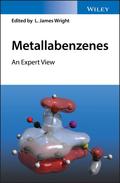Metallabenzenes
An Expert View

1. Auflage Oktober 2017
328 Seiten, Hardcover
Wiley & Sons Ltd
The only comprehensive book covering of advances in metallabenzene chemistry--written by the leading experts in the field
Metallabenzenes: An Expert View provides comprehensive coverage of all aspects of metallabenzene chemistry, including syntheses, reactions, physical properties, and theoretical treatments of metallabenzenes. Fused ring metallabenzenes, heterometallabenzenes, and metallabenzenes that are p-bound to other metal fragments are also discussed in depth.
Although benzene itself was discovered in 1825, it wasn't until 1982 that the first metallabenzene was isolated. Since then, interest in these compounds has built steadily, and metallabenzene chemistry is now a flourishing sub discipline in its own right. A diverse range of synthetic approaches to these compounds have been devised, and new developments and discoveries have appeared regularly over the past several decades. Yet, until now, no books devoted to this fascinating and important class of chemical compounds have been available to researchers and students. This bookfills that gap in the literature with a comprehensive review of recent advances in metallabenzene chemistry theory and applications. Featuring contributions by an international group of experts in the field, each chapter summarizes important recent research in and significant contributions to various aspects of metallabenzene chemistry.
* Provides academics, researchers and graduate students with a comprehensive review of advances in metallabenzene research
* Covers fused-ring metallabenzenes--including metallanaphthalenes, metallabenzofurans, and metallabenzothiophenes--as well as p-bound heterometallabenzenes and metallabenzenes
* Reviews the latest computational studies that have led to the theoretical understanding of metallabenzenes
* Includes critical discussions of metallabenzene aromaticity, an area rarely covered by computational experts
Metallabenzenes: An Expert View is an important working resource for those working in organometallic chemistry, aromaticity, coordination chemistry, theoretical chemistry, catalysis and materials science. It is also an excellent text for graduate-level courses in those areas.
1.1.Introduction.
1.2.Syntheses and properties of metallabenzenes with methylthiolate substituents
1.3.Syntheses and properties of fused-ring metallabenzenes
1.4.Reactions of metallabenzenes and metallabenzenoids
1.5.Concluding remarks
References
Chapter 2: The First Iridabenzenes: Syntheses, Properties and Reactions
2.1 Introduction
2.2 Basic Theory
2.3 Discovery of the First Stable Metallabenzenes
2.4 Synthesis of Iridabenzene
2.5 Valence Bond Structures and Electron Counting for Iridabenzene
2.6 The Tris(trimethylphosphine) Reaction System
2.7 Structure and Spectroscopy of Iridabenzene
2.8 Chemical Reactivity of Iridabenzene
2.9 Iridaphenol
2.10 Synthesis and Spectroscopy of Iridapyrylium
2.11 Valence Bond Structures and Electron Counting for Iridapyrylium
2.12 Chemical Reactivity of Iridapyrylium 37
2.13 Comparison of Iridabenzene 3 and Iridapyrylium 37
2.14 Synthesis and Spectroscopy of Iridathiabenzene
2.15 Structure of Iridathiabenzene 50
2.16 Chemical Reactivity of Iridathiabenzene 50
2.17 Comparison of Iridathiabenzene 50 and Iridapyrylium 37
2.18 Synthesis and Structure of a Neutral Iridathiabenzene
2.19 Spectroscopy of Neutral Iridathiabenzene 56
2.20 Chemical Reactivity of Neutral Iridathiabenzene 56
2.21 Related Metal-Coordinated Metallabenzenes
2.22 Aromaticity
2.23 Final Word
References
Chapter 3: Metallabenzenes and Valence Isomers via the Nucleophilic 3-Vinylcyclopropene Route
3.1.Project Origin and Inspiration (A Nod to Binger, Bleeke, Grubbs, Hughes and Roper)
3.2.Ligand Synthesis (An Exercise in Over-Engineering)
3.3.Iridabenzenes and Valence Isomers (Success After Six Long Years)
3.4.Platinabenzenes (How To Get Your Chemistry on a Beer Coaster)
3.5.Odds and Sods (Ones That Got Away)
3.6.Conclusion (So Long, and Thanks for All the Fish)
Chapter 4: Iridabenzenes and iridanaphthalenes with supporting tris(pyrazolyl)borate ligands.
4.1 Introduction
4.2 Synthetic routes to iridaaromatic derivatives with supporting tris(pyrazolyl)borate ligands
4.3 Reactivity of iridaaromatics with supporting tris(pyrazolyl)borate ligands
4.4 Structural data for iridaaromatics with supporting tris(pyrazolyl)borate ligands
4.5 Spectroscopic data for iridaaromatics with supporting tris(pyrazolyl)borate ligands
4.6 Conclusions
References
Chapter 5: Chemistry of Metallabenzynes and Rhenabenzenes
5.1.Introduction
5.2.Chemistry of metallabenzynes
5.3.Chemistry of rhenabenzenes
5.4.Summary
References
Chapter 6: Metallabenzenoid Compounds bearing Phosphonium Substituents
6.1 Synthesis
6.2 Structure and Bonding
6.3 Reactions
6.4 Physical Properties
6.5 Polycyclic Metallabenzenoid Compounds bearing Phosphonium Substituents
6.6 Future Prospects
References
Chapter 7: Theoretical Studies of Metallabenzenes: From Bonding Situation to Reactivity
7.1 Introduction
7.2 Structure and Bonding Situation
7.3 Computational Studies on Synthetic Pathways Towards Metallabenzenes
7.4 Computational Studies on the Reactivity of Metallabenzenes
7.5 Concluding Remarks and Outlook
References


